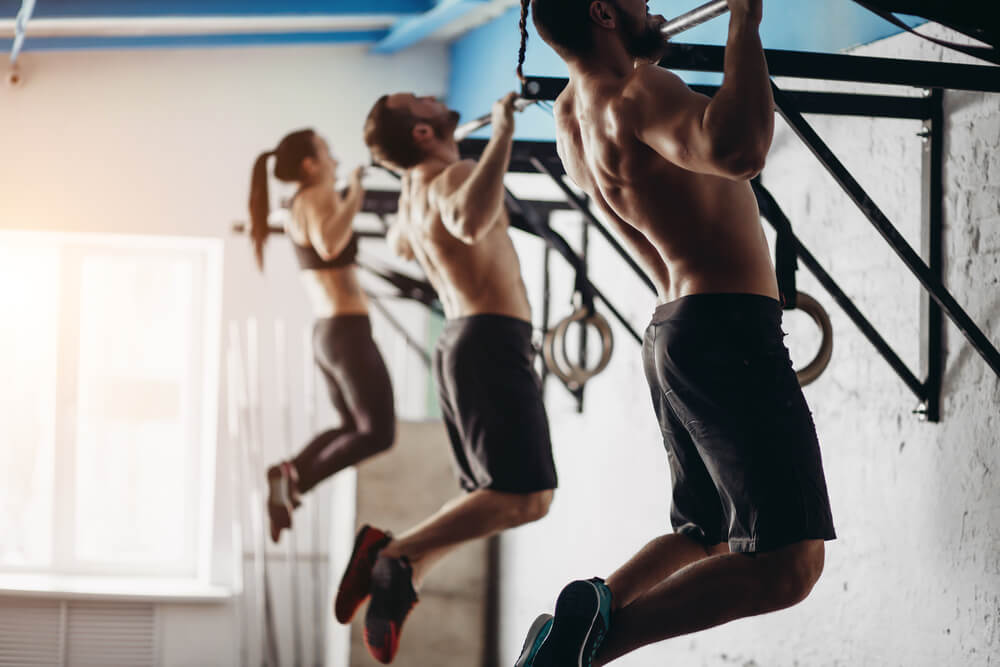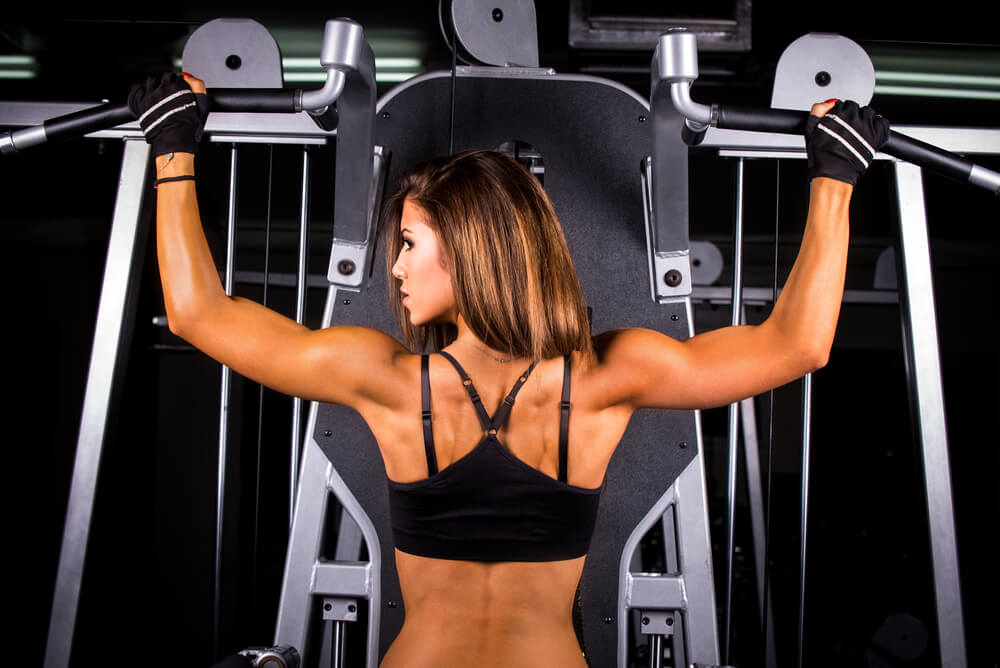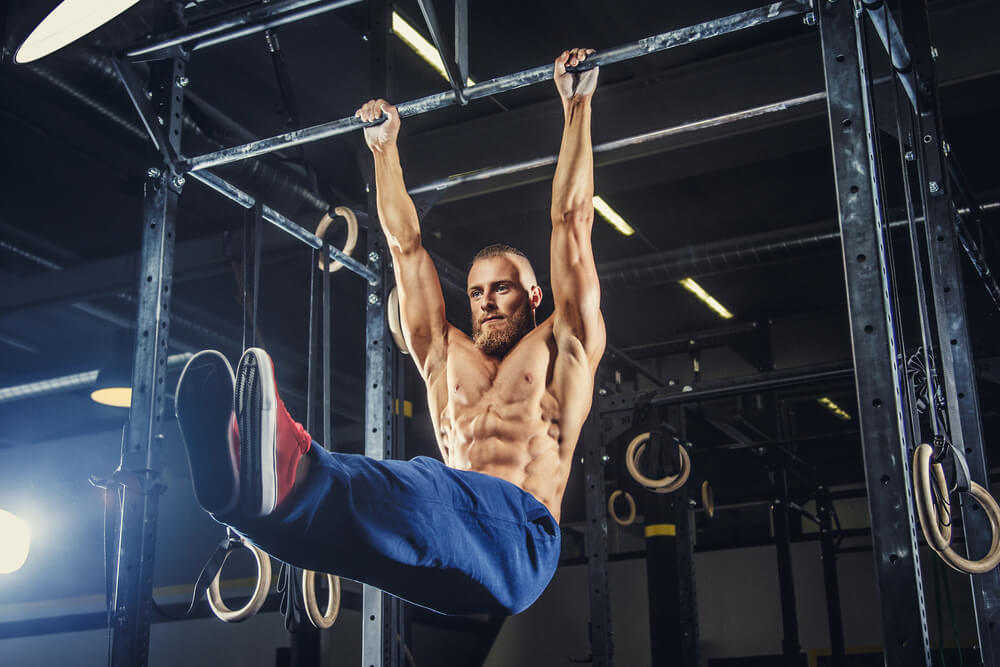Remember a time when a piece of playground equipment use to be nothing but a row of chin up/pull up bars strung together?
As a kid, you could probably swing off of those monkey bars all recess.
Now, if you were to go out and try to do the same, you might get across two bars before your back gives out, or at the very least your legs crash into the gravel and you sprain a toe.
It’s possible to pack in a solid resistant workout without actually using any physical weight, and much of this has to do with the classic chin up/pull up bar.
Of course, if you were to go to the store now you’d find some outlandishly crazy bars available, which look more like giant spider decorations for your door frame than workout equipment.
Beyond all of these fancy devices and the dozens of variations, do you actually know the difference between a chin up and a pull-up?
If not, we’re about to tell you.
And if you do?
Well, keep on reading, because there’s plenty of good stuff packed in here anyway.
Chin Up vs Pull Up
Let’s start with the actual move itself and then look at how the two different moves are different from one another.
How to Do a Pull-Up and Chin Up
With the pull-up, you’ll take hold of the bar with your palms facing away from you.
With a traditional pull up you’ll have your grip right around shoulder width apart (although there are variations to this). Pull yourself up until the top of your chest is even with the bar, then slowly lower yourself back down.
You may also find it easier to lock your feet together, so one is directly behind the ankle of the other foot.
This helps center your line of gravity and can reduce swaying or be putting too much of your body weight on one side, which forces your left or right upper body to work harder than the other side.
The chin-up is very similar in actual movement. The main difference here is the grip. You’ll take hold of the bar so the back of your hands faces away from you. Maintain a shoulder-width grip and lift yourself up. One set is complete after you lift your chin over the bar.
Your forearm will touch your bicep, making it impossible to lift any higher. Lower yourself back down to complete a rep. Again, you’ll want to tuck one foot behind the other to help anchor off your weight.
As you can see, in terms of form, the only real difference, at least when comparing the base, traditional moves, is how you hold onto the bar. Of course, as you know from other lifts, the way you grip the exercise equipment can play a major role in what muscles you work.
So let’s get into the exact muscles the chin up and pull up moves actually touch on.
Chin Up vs Pull Up: What Muscles Used?
Whenever you workout your body, you’ll use primary and secondary muscles. These secondary muscles are a bit more than just stabilizing.
Due to gravity pulling down on you the muscles will receive a nice workout, although the primary muscles remain the target.
When you’re performing a pull-up, the main front upper body muscles you work are the biceps. The exact heads you hit and the impact will vary based on the variation or grip you use, but in terms of the traditional pull-up, where your arms are right around shoulder length, you’ll hit the biceps the hardest.
On the back, you’ll hit your lats (latissimus dorsi) the most. You’ll also touch on the triceps and a portion of your pectoral muscles as this is a difficult area to hit for many people at the gym, the pull up should become indispensable as a workout move.
In terms of secondary muscles used, just about all of your upper back is used, including the upper back muscles and posterior deltoids (although you do miss out on the top portion of the traps, as this is more of your neck than back). On the front of your body, you’ll work your forearms and your abs work as stabilizer muscles to keep your body from swinging.
In terms of the chin up, you’ll feel this more in your arms than in your chest. While the pull up did touch on the biceps, you’ll really feel it with the chin up.
The chin-up targets the biceps the most.
You’ll also feel it with your delt muscles and with the lats of your back. In addition, you’ll use your forearms as secondary muscles, ad the abdominal muscles work as stabilizers.
Okay, So Muscles Are Similar, What’s the Real Difference?
After going through the muscles, you can see even the muscles you touch upon are similar. It just goes to show you both are great for working the upper body.
The true beauty and difference comes from the width of your grip and what you want to target.
If you’re someone who changes up the width of their grip on a bench press, you know having a closer grip focuses on your biceps, while a wider grip puts more weight on your chest. That is similar in practice with these moves.
The pull up (just as a reminder, as it is easy to get the two confused, the pull up is where your palms are facing away from you) is best for hitting your chest and your lats. This is because your grip will normally be a bit wider.
In fact, if you take one arm and mime like you’re going to perform a pull up as you’re sitting and reading this, take your other arm and feel your upper body muscles. You’ll be able to identify exactly which muscles are tensing up and working.
Now, move the arm further away from you, as if you were taking a wider grip.
You can feel how and where the muscles change. You should feel it in your chest as well, as a closer grip pull up hits the inner and middle portions of your pecs, while a much wider grip hits right around the arm pit. The same happens with your lats.
The chin up is fantastic for blasting your biceps and your delts.
Again, if you feel your arm as you mime the move, you can really see how the front and side of your shoulders are hit with the move (it is a bit difficult to feel exactly what you’re hitting in the back, so you’ll have to take our word for it).
Put together, the chin up and the pull up really work the vast majority of your upper body.
Why Can I Do One Better Than The Other?
If you’ve been working with the pull-up and chin-up moves, you likely have noticed you can perform one far better than the other.
This comes down to the strength of the target muscles.
Most people are able to do the chin up because they already have stronger biceps. It’s not difficult to work the bicep. If you really get down to it, the bicep is probably the easiest muscle to work in the upper body (and most people work it anyway because they want the larger arm look).
The pull up requires more strength from your upper chest and your back, which may not be as strong as your biceps and delts. Due to this, you might struggle more with the pull-up. Thankfully, this means you just need to start doing more of the lift you’re struggling with (and add in more resistance and weight training for the areas of the body as well).
The pull up and chin up moves are great for seeing exactly how strong different muscle groups are. You may surprise yourself (in one way or another). If you haven’t worked for a particular muscle group much during your upper body workouts (typically the back) then you’ll see limited results with the chin up and pull up.
Variations of the Chin Up vs Pull Up Moves
The beauty of the pull-up bar is all the different kinds of variations you can do with one move like the squat bench pull up for example.
Realistically, if you’re looking to build a home gym, this should be the first piece of equipment you purchase. It’s inexpensive, can fit in a door frame (there are some that don’t even require drilling or screws) and you’ll work your entire upper body.
If you’re looking for the best of both worlds, you can use a mixed grip move.
This is where one arm is in a pull-up position and the other is in a chin-up position. This forces each side to work even harder to compensate for the other side’s shift in grip position. It’s also a great muscle confusion technique, if you’ve been performing pull ups and chin ups for a while now.
Beyond the switch grip position, you can bring your arms in closer. The closer the grip, the more you’ll focus on the center of your body. In other words, you’ll hit more of your biceps, and your chest. As you move the grips outward, you’ll begin to work more of your arms.
The benefit of moving your arms outward is you won’t rely as much on the front of your body, which you’ve likely been working out more, and increase the reliance on the back of the body.
It is easy for the front of your body to take over during a pull up or chin up simply because it is more developed and can lift more. By shifting how you hold the bar and how you perform the moves, you’ll be able to target more specific areas of the upper body.
Another variation is dipping your head in front of the bar.
So, instead of lifting yourself up so your chin goes above the bar, you’ll lift yourself up so your head goes in front of the bar. This puts far more pressure on your upper back, traps and neck area.
If this is an area of concern or a spot on your body you want to hit more, make sure to bring this kind of move into the routine.
So How Much and How Many?
So how many sets and reps do you do?
Realistically that is up to you.
How many can you actually do?
If you’re starting off, it might only be a handful. There are some who are not able to get up a single rep. Not a problem. Just means you’ve got nowhere else to go but up.
In the beginning, just focus on doing as many as you can until failure.
Alternate each set between pull ups and chin ups (if on Monday you do pull ups first, switch to doing chin up first on your next upper body day) until you complete three sets of as many reps as you can each.
When it gets to the point where you’re able to pump off 20 or more reps on subsequent sets, it means it is time to start adding a bit more weight to your lift. Using a weighted belt, you can begin increasing your resistance. You can also purchase a weighted vest for this move as well.
Conclusion
Both chin up and pull up exercises are some of the best upper body exercises you can perform. Using the aid of your own body weight and gravity, you don’t need any additional weight to assist you with the move.
Best of all, there are all sorts of variations, allowing you to touch just about every single muscle group in your upper body. Investing in a chin up/pull up bar gives you a great tool for ab workouts as well.
So, if you’re not performing these exercises during your upper body routine, now is the perfect time to start.
-Terry Asher
Terry Asher
Latest posts by Terry Asher (see all)
- Better Family – Product Review Liquid Daily 2 oz - Dec 16, 2024
- Post-Workout Recovery: The Key to Optimal Performance - Nov 25, 2024
- Pre-Workout Supplements – Everything You Need To Know - Nov 18, 2024













[…] via- https://gymjunkies.com/chin-up-vs-pull-up/ […]
The useful blog for fitness and diet tips, keep it going!
This is really useful to have all these great blogs in one place. I really like fitness tips, great design, and interesting Articles!
[…] of the best ways to build strength for this is to work on your pull-up and chin-up. While you are using a horizontal bar instead of a vertical bar, increasing your strength with […]